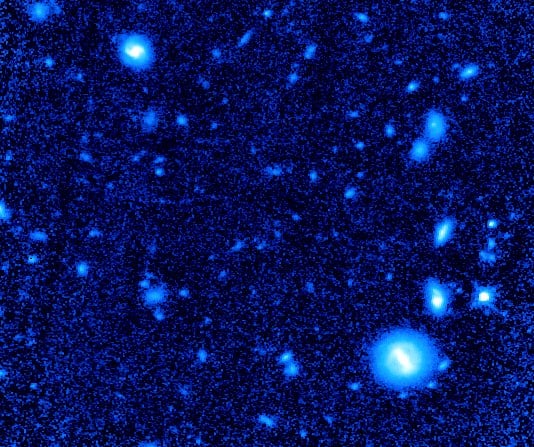[/caption]
A new survey is revealing how the most massive galaxies formed in the early Universe, and the findings support the theory that Cold Dark Matter played a role. A team of scientists from six countries used the NICMOS near infrared camera on the Hubble Space Telescope to carry out the deepest ever survey of its type at near infrared wavelengths. Early results show that the most massive galaxies, which have masses roughly 10 times larger than the Milky Way, were involved in significant levels of galaxy mergers and interactions when the Universe was just 2-3 billion years old.
"As almost all of these massive galaxies are invisible in the optical wavelengths, this is the first time that most of them have been observed," said Dr. Chris Conselice, who is the Principal Investigator for the survey. "To assess the level of interaction and mergers between the massive galaxies, we searched for galaxies in pairs, close enough to each other to merge within a given time-scale. While the galaxies are very massive and at first sight may appear fully formed, the results show that they have experienced an average of two significant merging events during their life-times."
The results show that these galaxies did not form in a simple collapse in the early universe, but that their formation is more gradual over the course of the Universe's evolution, taking about 5 billion years.
[caption id="attachment_29808" align="aligncenter" width="250" caption="NICMOS image of merging galaxies. Credit: C Conselice, A Bluck, GOODS NICMOS Team"]
[/caption] "The findings support a basic prediction of the dominant model of the Universe, known as Cold Dark Matter," said Conselice, "so they reveal not only how the most massive galaxies are forming, but also that the model that's been developed to describe the Universe, based on the distribution of galaxies that we've observed overall, applies in its basic form to galaxy formation."
The Cold
Dark Matter theory
is a refinement of the Big Bang theory, which includes the assumption that most of the matter in the Universe consists of material that cannot be observed by its electromagnetic radiation and hence is dark matter, while at the same time the particles making up this matter are slow and are thereforer cold.
The preliminary results are based on a paper led by PhD student Asa Bluck at the University of Nottingham, and were presented this week at the European Week of Astronomy and Space Science at the University of Hertfordshire.
The observations are part of the Great Observatories Origins Deep Survey (GOODS), a campaign that is using NASA's Spitzer, Hubble and Chandra space telescopes together with ESA's XMM Newton X-ray observatory to study the most distant Universe.
Source: RAS
 Universe Today
Universe Today
